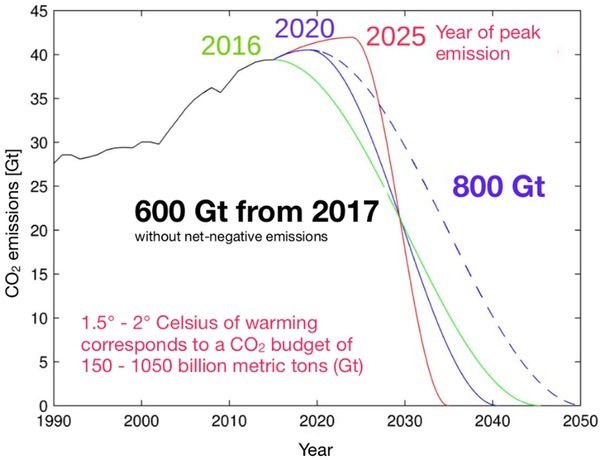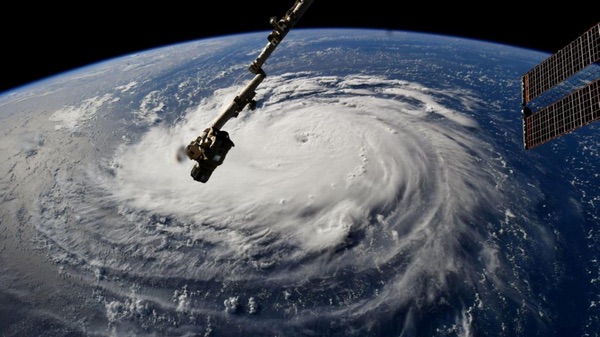Why addressing the environmental crisis should be the space industry’s top priorityby Loïs Miraux
|
| These epic endeavors do not help us tackle the challenge of our century, which is facing the environmental crisis and its consequences, and not making the human species multiplanetary. |
However, while the current planetary crisis constrains us to sobriety, a number of space projects are looking the other way. Megaconstellations of satellites such as Starlink are being deployed to provide Internet access even in the most remote places on Earth, thriving on the frenetic practice of high frequency trading,[2] while digital technologies now account 4% of greenhouse gas emissions and are expected to reach 8% by 2025 [3]. In an era of “flygskam” or “flight-shame”—the environmental guilt of flying—some private companies are investing in the emerging market of space tourism, like Blue Origin and Virgin Galactic, which is expected in one forecast to grow by 16.6% through 2024.[4] A space hotel in a private space station is even expected around 2024.[5] Space agencies and private companies are also proposing settlements on the Moon and on Mars, to mine resources or even to provide to humanity a “Planet B”. In April 2020, US President Donald Trump signed an executive order reaffirming a decision made by Congress in 2015 stating America has the right to explore and use resources from outer space, putting aside historic treaties that view space as a “global commons” to be governed by international bodies.[6]
Trump’s executive order paves the way to a new headlong technological rush into the solar system. These projects appear as an ultimate, desperate rush to push back the limits of growth, while shortages and geopolitical tensions on Earth enable us to perceive these limits clearer than ever.
How space exploration will save us, or the ultimate technological solutionism
It is true that, looking back to the story of science and technology, these projects could look like pioneering endeavors that will ultimately be beneficial for humanity. It is a natural step in the history of a civilization looking to keep growing to go out of its home planet, exploit resources in its surrounding space, and ultimately settle its planetary system. But as humans on Earth are facing serious existential threats, will we make it on time?
We are told that asteroid mining will solve our shortages in minerals and metals, which are so important to make our transition towards low-carbon energies like solar and wind, and to fuel our ever-growing demand in tons of applications, from mobile phones and computers to chemical catalysts. However, roadmaps built up by specialists—which did not predict the failures of the two main asteroid mining companies, Planetary Resources and Deep Space Industries—indicate that first mining missions may happen only by 2040.[7] Space-based solar power stations would overcome the issues of Earth-based solar and wind, whose intermittency and need of storage cannot bring us towards near-zero emissions. But even betting on plummeting launch costs that are still far from reality today, this could hardly become real before another 50 years.[8,9] The settlement of Mars, apart from pure scientific objectives, would even provide us with a “Planet B” in case life on Earth becomes impossible. But terraforming Mars, assuming that it is possible, would take about 100,000 years according to some estimates.[10,11] Yes, in a couple of decades, some lucky few may be able to retire under a dome in a Mars colony while life on Earth becomes more and more difficult, but it is a rather bleak prospect.
These epic endeavors do not help us tackle the challenge of our century, which is facing the environmental crisis and its consequences, and not making the human species multiplanetary. Because there is not much sense in making like multiplanetary if it collapses or even becomes extinct right after. This is not about criticizing these endeavors themselves as if they were inherently bad; it is rather about showing that, in this unique context in the history of humanity, where our home planet is quickly becoming uninhabitable, their inability to help make them secondary at best, if not completely irrelevant. They promise technological solutions not realistic within the time scale of the current crisis, which shows a profound misunderstanding of the crisis itself among some of their advocates. The target of the Paris agreement, which is paramount to meet in order to avoid dangerous nonlinear and irreversible effects,[12] requires a profound transformation of our societies by 2050, beginning now. Such a transformation is likely to trigger social instability and geopolitical tensions reinforced by a fast-changing climate and resource depletion.[13,14] Consequently, the credibility and popularity of these technical solutions in space will probably decrease, making them even more difficult to achieve.
 Emission budget and necessary emission reduction pathways to meet the 2°C target agreed in Paris [15] |
Drive the space industry towards prioritization of climate and environmental action
An important questioning needs to be done within the space community on the priorities it should consider when allocating money and efforts, at the dawn of the second decade of “The century of threats” as Jacques Blamont puts it [16], the founder and former scientific and technical director of the French space agency (CNES).
| The space industry will have a strategic role to play to adapt to, predict, and mitigate climate change. It relies intrinsically on advanced technologies, which inevitably raises sustainability issues. |
The acceleration of climate change along with the multiplication of natural disasters will require an increase in space-based Earth observation assets and better international cooperation. In the context of economic restrictions combined with all kinds of instabilities and difficulties resulting from the environmental crisis [17], a redefinition of priorities is likely to be needed towards Earth observation applications at the detriment of other applications. Of course, the interest of various scientific missions remains relevant and fighting climate change should not stop us in our quest for knowledge. But we are arguably facing the greatest challenge in the history of mankind. Every effort that can be made to address it must be taken, while practices and projects going the other way must be avoided.
A space industry in the age of low-tech and low environmental impact?
To continue human activities within planetary boundaries, industries need to rethink their processes. Upcoming energy and resources shortages may lead to the use of simpler methodologies and technologies. As discussed, the space industry will have a strategic role to play to adapt to, predict, and mitigate climate change. It relies intrinsically on advanced technologies, which inevitably raises sustainability issues.[18] However, due to this strategic role and its small relative environmental impact, it is possible that the space industry will constitute an exception in some aspects, in a similar fashion as, for instance, the medical domain; yes to high-tech surgical instruments, no to smart toasters. In this regard, the resilience of material and energy supply chains needs to be investigated. Given the significant military interests in the space industry, this may also be relevant for national security issues.
In addition, the resilience of a society relying on space-based assets like telecommunications and positioning must be assessed in the context of the planetary crisis, as well as its medium- and long-term consequences on the evolution of the space market needs.
| We, space people, can decide to include in our efforts and jobs a greater environmental ambition. We can transform our industry to be dedicated to monitor and mitigate climate change. |
Finally, more analyses on the environmental impact of the space industry needs to be done (use of rare earth elements and chemicals, energy-consuming facilities, impact on launches on the ozone layer),[19,20] including the evolution of space debris. This is all the more important that the market is expected to grow at a high pace in the near future. If this environmental crisis showed one thing, it is that the human mind is not good in anticipating exponential growth.
For a green space industry
A completely different model of society needs to be found and implemented to respect the planetary boundaries while staying above social thresholds. In this context, it is legitimate to question the practices of the space industry and its role in achieving this goal.
We, space people, can decide to include in our efforts and jobs a greater environmental ambition. We can transform our industry to be dedicated to monitor and mitigate climate change, to efficiently manage the increasing number of disasters and crises resulting from its effects, and to help the transition towards a low-carbon society, all while avoiding development of space applications on Earth that are polluting, that favor consumerism, or that accelerate the destruction of the environment. We can make our industry itself more sustainable. Ecology should be placed at the heart of space activities.
References
- CNES, “Climat,” 2020.
- S. Rosov, “SpaceX Is Opening Up the Next Frontier for HFT,” 2020.
- The Shift Project, “Climate crisis: the unsustainable use of online video,” 2019.
- FiorMarkets, “Global Space Tourism Market Growth (Status and Outlook) 2019-2024,” 2019.
- J. Luczak-Rougeaux, “Le premier hôtel spatial verra le jour en 2024,” Tom, 24 July 2020.
- M. Wall, “Trump signs executive order to support moon mining, tap asteroid resources,” Space.com, 06 April 2020.
- International Space University, “Asteroid Mining Technologies Roadmap and Applications,” 2010.
- J. C. Mankins, “Hearings on Solar Power Satellites,” U.S. House of Representatives, 2000.
- A. P. Smith, “The Case for Solar Power From Space,” Ad Astra, vol. 16, no. 11, 2004.
- A. Chen, “The Feasibility of Mars Colonization as an Alternative Human Habitat: A Futuristic Outlook,” 2018.
- C. P. McKay, “The Physics, Biology, and Environmental Ethics of Making Mars Habitable,” Astrobiology, vol. 1, no. 11, 2001.
- H. J. Schellnhuber, S. Rahmstorf et R. Winkelmann, “Why the right climate target was agreed in Paris,” Nature Climate Change, vol. 6, pp. 649–653, 2016.
- IPCC, “Climate Change 2014: Synthesis Report. Contribution of Working Groups I, II and III to the Fifth Assessment Report of the Intergovernmental Panel on Climate Change,” Geneva, Switzerland, 2014.
- J.-M. Valantin, Géopolitique d’une planète déréglée, Seuil, 2017.
- Wikipedia, “Emissions budget.”
- J. Blamont, Introduction au siècle des menaces, 2004.
- S. S. Sharma, “The relationship between energy and economic growth: empirical evidence from 66 countries,” Applied energy, vol. 87, no. 111, pp. 3565–3574, 2010.
- P. Bihouix, L'Âge des low tech, Seuil, 2014.
- ESA, “How to make environmental friendly space missions,” Clean Space, 20 April 2018.
- L. David, “Spaceflight Pollution: How Do Rocket Launches and Space Junk Affect Earth’s Atmosphere?” 2017.
Note: we are temporarily moderating all comments submitted to deal with a surge in spam.
